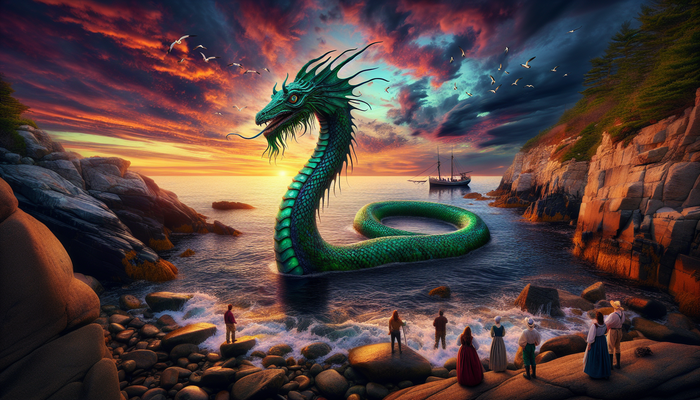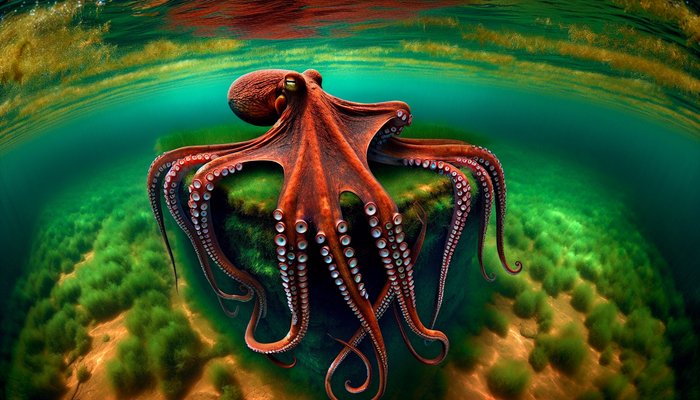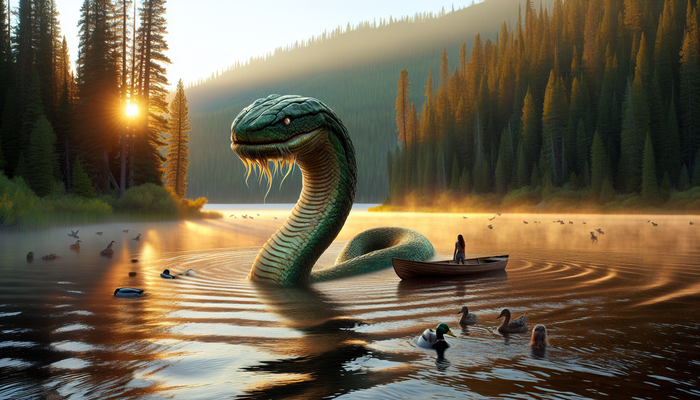From Fog to Fright: The Pensacola Sea Serpent

By Lucas Jennings, Cryptozoologist and Adventurous Naturalist
Introduction
The ocean holds endless mysteries. As someone who has dedicated his life to unveiling the secrets of the natural world, few things intrigue me more than the tales of strange creatures glimpsed beneath the waves, defying explanation or categorization. The depths conceal more than we could ever know, and from time to time, the denizens of this watery realm reveal themselves in fleeting encounters that leave us questioning what we think we know.
One such encounter occurred in March of 1962 off the coast of Pensacola, Florida. A pleasant day of adolescent adventure turned into a harrowing fight for survival, leaving one young man haunted and four families devastated. The lone survivor's account suggests an attack by a beast unknown to science, a predator of singular ferocity that claimed its prey amidst a veil of fog before slipping back into the murky depths.
The incident has captured the imagination of the cryptozoological community, inspiring awe and skepticism in equal measure. As an adventurous naturalist driven by curiosity, I am compelled to shine a light on this mystery and analyze the evidence at hand. The possibility of an undiscovered marine species evokes both fear and wonder, and this tale in particular stands as a cautionary reminder that the sea conceals as much as it reveals.
In this article, I will delve into the infamous Pensacola sea serpent encounter, recounting the fateful expedition and analyzing the lone survivor's chilling story. Weighing skepticism against speculation, I will explore the various theories put forth to explain this cryptid sighting and the tragic events that followed in its wake. This enigmatic creature's legacy serves as a symbol of our eternal fascination with the unknown, that realm where the line between reality and imagination blurs. Join me as we unravel the mystery of the Pensacola sea serpent, and perhaps glimpse the untamed wilderness that lies beneath the waves.
The Fateful Expedition
Edward Brian McCleary could hardly contain his excitement on the sunny March morning of 1962 as he and four friends departed on what was meant to be a thrilling aquatic adventure. The group of eager teens were setting out to explore the wreck of the USS Massachusetts, an alluring shipwreck lying approximately two miles off the coast of Pensacola, Florida. For these young men, the ill-fated vessel was a playground for underwater exploration and discovery, promising a day of freedom and excitement beneath the waves.
Accompanying the 16-year-old McCleary were 17-year-old Warren Salley Jr., 16-year-old Eric Ruyle, 15-year-old Larry Bill, and 14-year-old Bradford Rice. The tight-knit group were well-acquainted with the waters of Pensacola Bay, having skin dived among the corals and shipwrecks of the region on many occasions. Skin diving, also known as free diving, involves underwater swimming without the aid of breathing equipment, relying solely on a diver's ability to hold their breath. It was a pastime that all five boys enjoyed immensely.
After checking the morning weather report and seeing clear skies ahead, McCleary and his eager friends packed up their diving gear and provisions and headed to Fort Pickens State Park, at the western tip of Santa Rosa Island. From this vantage point, the wreck of the USS Massachusetts was visible, its rusting masts jutting from the shimmering blue waters approximately two miles offshore.
Having confirmed their destination, the boys carried their seven-foot rubber raft down to the water's edge and inflated it. They would take turns paddling out to the wreck, not wanting to expend all their energy before the adventure had even begun. As the raft slid into the crystal waters of the bay, the boys clambered aboard, giddy with excitement for the day ahead.
The Encounter Unveiled
As the raft drifted farther from the shore, laden with its animated cargo, the winds began to transform from a gentle breeze to an insistent gale. Swells rose and fell around the small vessel as clouds rolled in, turning the calm bay into a frothing cauldron. McCleary and his friends strained against the oars, struggling to make headway as the storm grew in fury. The Massachusetts faded from view, lost in the roiling mists that now enveloped the desperate crew.
Night fell, and with it came an eerie fog that reduced visibility to no more than twenty feet in every direction. The sodden, exhausted boys huddled in their battered raft, adrift in an ocean gone mad. It was then, amidst the moaning winds and swirling vapors, that it appeared. McCleary spotted it first, less than fifty feet from their fragile craft. He would later describe it in chilling detail: a telephone pole-like shape, some ten feet in height, with a bulbous top. Though visibility was severely impaired, McCleary noted the creature's long, sinuous neck and small, beady eyes.
As the boys looked on, paralyzed with terror, the beast let out an unearthly, high-pitched whine. Then, before their disbelieving eyes, it bent its body in half and slipped below the waves. The creature's intentions soon became shockingly clear. In their panicked scramble to flee the monster, McCleary witnessed the sea serpent seize his friends one after another, its jaws claiming their lives. His account describes the beast grabbing Eric Ruyle and pulling him into the depths, while Warren Salley's cries of "It's got Brad!" echoed over the thrashing seas before being abruptly silenced.
Against all odds, McCleary managed to struggle to shore, where he took shelter inside an abandoned tower on the beach. By dawn, a helicopter crew had spotted him and transported the dazed, traumatized young man to the naval hospital. Though his four friends could not be found, McCleary maintained that a sea monster was responsible for their disappearance. His harrowing tale was met with raised eyebrows and skepticism. And yet, McCleary never wavered in retelling the horrific events of that night.
Skepticism and Speculation
McCleary's account strains credulity, to put it mildly. A sea monster appearing amidst a storm to pick off four athletic young men defies belief. Upon closer examination, however, the story contains unsettling hints of truth. McCleary's four friends did indeed disappear that night, their bodies never recovered save for one that washed ashore days later. The cause of death was determined to be drowning, with no mention of telltale wounds one would expect from a monster attack.
Understandably, many have written off McCleary's story as a fanciful tale conjured by trauma and terror. They suggest he imagined the creature, its image perhaps inspired by a popular sea serpent cartoon character named Cecil that aired months prior. Hallucinations brought on by stress and exhaustion could also account for the vivid encounter described by the lone survivor.
While these are plausible explanations, as an open-minded skeptic I am reluctant to dismiss the story outright. Trauma affects individuals in complex ways, and it is presumptuous to assume we know the workings of McCleary's mind during the harrowing ordeal. Imagination can run wild when fueled by fear, but the human psyche also seeks patterns and explanations. Could McCleary's account represent a truthful recollection of events that defies conventional understanding? As an explorer of the unknown, I do not disregard even the most fantastical tales without thorough examination of the facts.
Theories and Possible Explanations
Assuming McCleary's report contains at least some basis in reality, what might account for the attack he attributes to a sea monster? Several plausible theories have been proposed:
Misidentified Known Animal
Many suggest McCleary encountered a known marine animal that was misconstrued as a sea monster in the chaos of the moment. Sharks, dolphins, seals, and even large squid could potentially inspire fear and be perceived as threatening under distressing circumstances. A pod of dolphins swimming in close formation, for example, may resemble a single serpentine creature to young men already gripped by panic.
Giant Squid
The most likely candidate is the giant squid, reaching astonishing lengths of up to 43 feet. Their elongated bodies and large, bulbous heads match McCleary's description. Giant squid inhabit deep ocean environments, but may occasionally surface, especially when sick or injured. The creature's enormous tentacles could easily appear as a long neck and attack swimmers, as squid are in fact aggressive when threatened. The foul odor preceding its arrival offers further evidence, as squid release ammonia when stressed.
Undiscovered Species
While giant squid account for many maritime monster sightings, some believe McCleary's vivid description points to an undiscovered predator. Our oceans undoubtedly contain unclassified species, and relict populations persisting from prehistoric times are not unheard of. If an aggressive eel-like creature dwells in the Gulf of Mexico, it could conceivably attack humans and retreat quickly to the ocean's veiled depths. Skeptics argue that a large marine predator could not evade detection and documentation in well-traveled waters, and yet the possibility cannot be excluded given how little we know of the sea.
Psychological Factors
Trauma affects the mind in complex ways, as I noted earlier. While McCleary's account appears too detailed to be pure confabulation, psychology likely played a role. The theory of a "shared hallucination" proposes that under extreme conditions, groups can experience illusions, validating each other's false perceptions. McCleary's own mental state, combined with group psychology, may have conjured a monster that existed only in their terrified minds.
The truth likely incorporates elements of multiple theories. Trauma, misidentification, and imagination fused to create a monster born of the sea's mysteries. Only McCleary knows if he truly saw a living beast or a chimera summoned from his darkest nightmares.
The Legacy of the Pensacola Sea Serpent
Regardless of what transpired on that fateful night, the Pensacola sea serpent has cemented its place in cryptozoological lore. McCleary's sincerity, the corroborated deaths of his friends, and the lack of evidence pointing to a hoax have kept the story alive for decades. Some consider the encounter a dramatic example of an undiscovered species, while others view it as a cautionary tale of the fallibility of human perception.
For me, the legacy of this incident is its embodiment of humanity's timeless awe and unease in the face of the unknown. Since ancient times, maritime folklore has been steeped in tales of sea monsters and serpents of enormous size, often regarded as harbingers of ill fate. Water's impenetrable depths have always harbored mystery, holding untold secrets beyond where sunlight's reach ends.
So while the truth of McCleary's experience eludes us, it taps into our most primal fears of the unseen predators that may lurk just out of view. Our knowledge of the ocean's expanse is dwarfed by all that remains obscure. And who knows what revelations await beneath the waves, in the abyssal plains that no human eyes have gazed upon? The Pensacola sea serpent is a symbol of all that we have yet to fathom.
Exploration vs. Mystery
Our oceans cover over 70 percent of the planet's surface, yet by most estimates we have explored less than 5 percent of their total volume. These staggering statistics highlight how much our seas have yet to reveal. Technological limitations restrict our access to the extreme depths and remote reaches of the marine world. What wonders and horrors lurk in this underwater realm yet unseen by human eyes?
While technology progresses, allowing us to probe ever deeper, the oceans should still be approached with humility and reverence. To dismiss tales like that of the Pensacola sea serpent simply because they do not align with current science is arrogant. Exploration must be tempered with the understanding that we are interlopers in a domain not our own, where unknown dangers may await. There are realities about our world that defy comprehension.
At the same time, we must not lose ourselves in fantastical speculation. The human mind seeks patterns and is prone to see monsters in the shadows. Trauma, isolation, and fear breed illusions that feel unequivocally real. We must weigh evidence with care and avoid leaping to paranormal conclusions, acknowledging the unreliability of memory and perception.
Maintaining this balance between open-mindedness and skepticism is critical as we strive to unravel our planet's remaining enigmas. The uncharted wilderness waits below, challenging us to shed our preconceptions and embrace its untamed mysteries. Perhaps one day, we will illuminate the secrets of the deep and bring creatures like the Pensacola sea serpent out of the realm of legend. Until then, we would do well to approach the ocean with reverence, never forgetting how much remains beyond the reach of our grasp.
Conclusion
The alleged events described by Edward Brian McCleary on that ill-fated night in 1962 continue to evoke fascination and controversy decades later. In the intervening years, no decisive evidence has surfaced to unravel the mystery one way or another. McCleary's account resists definitive classification as either fact or fiction. As with many incidents in the cryptozoological annals, the enigma of the Pensacola sea serpent persists.
This enduring uncertainty serves as a microcosm of humanity's relationship with the natural world's unknown dimensions. The ocean depths represent one of the last true frontiers, concealing secrets that both tantalize and unnerve us. Tales of sea monsters and serpents have populated maritime lore across cultures for millennia, speaking to our instinctual wariness of the water's dark expanse.
Perhaps the need to ascribe sinister forces to the sea's dangers reflects our unease with its indifference to human affairs. Its mysteries transcend us, humbling our desire for control and understanding. Or maybe, just maybe, the depths do harbor alien beings, relics from distant eras when the world was yet untamed. We can only speculate.
The story of the Pensacola sea serpent represents a modern manifestation of this age-old fascination and fear. Its enduring appeal owes much to its tantalizing ambiguity, balanced between implausibility and gruesome possibility. Ultimately, it serves as a reminder that knowledge has limits, and that nature does not exist for our benefit alone. If we wish to unravel the ocean's secrets, we must do so with patience, wisdom and care. The sea gives up its mysteries reluctantly. But for those with open minds and intrepid hearts, the search itself offers endless rewards.
From Bigfoot to UFOs: Hangar 1 Publishing Has You Covered!
Explore Untold Stories: Venture into the world of UFOs, cryptids, Bigfoot, and beyond. Every story is a journey into the extraordinary.
Immersive Book Technology: Experience real videos, sights, and sounds within our books. Its not just reading; its an adventure.



























